
Accomplishment Beavers
by Forest Musser ’29

Swords to Plowshares
Illustrations by Amanda Huston ’13, written by Lisa Weaver and published by the Lion and Lamb Peace Arts Center.
Art on campus
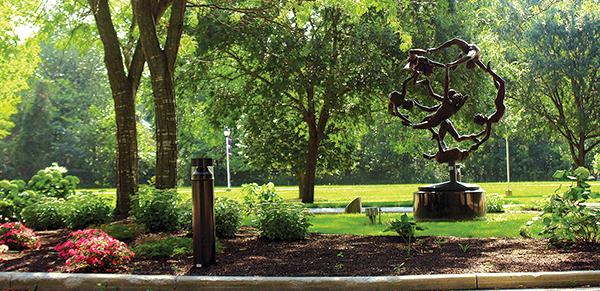
- Constellation Earth, bronze sculpture by Paul Granlund
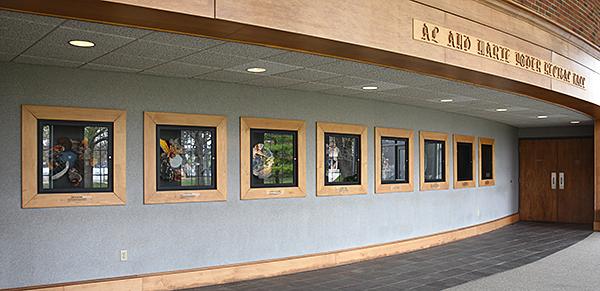
- The Creation Series, eight raku-fired ceramic plates by Gregg Luginbuhl
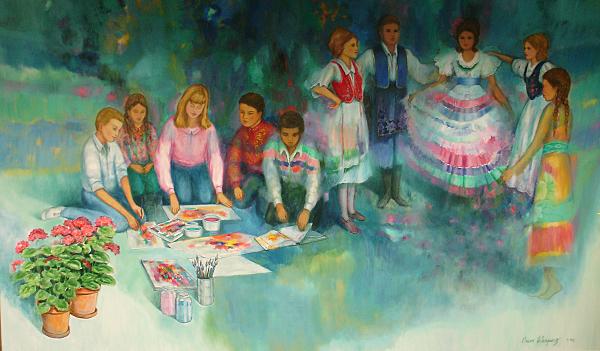
- A World of Youth, Hope and Peace, mural by Oscar Velasquez
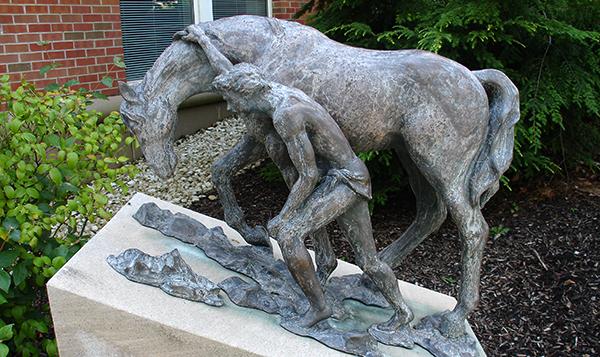
- Reaching Their Goal, One Step at a Time, bronze sculpture by Mary Kline Roynesdal '80
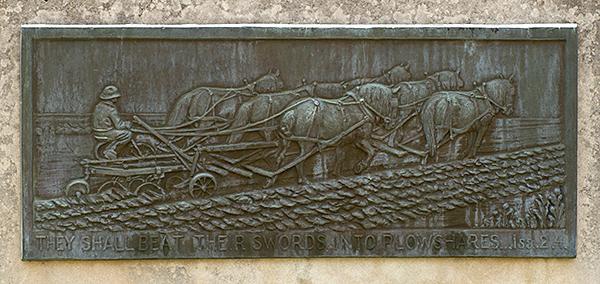
- Swords to Plowshares, bronze plaque by John Klassen
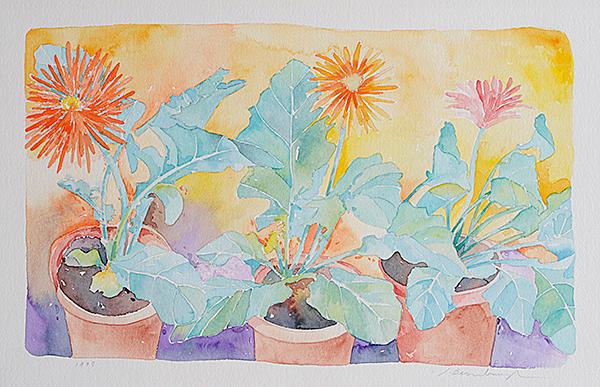
- Private Dreams, watercolor painting by Jaye Bumbaugh
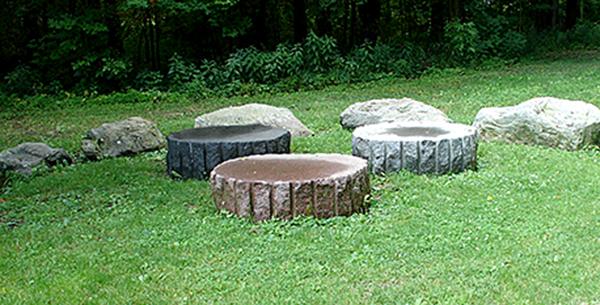
- Peace Thrones, by Bernadette D'Amore and Woody Dorsey
From one end of campus to the other, works of art are permanently on exhibit and are available for all to enjoy. This Art Walk starts in Riley Court, at The Lion and Lamb Peace Arts Center, and then heads to Sauder Visual Arts Center before crossing the creek to Marbeck Center, Centennial Hall, Musselman Library, College Hall and Yoder Recital Hall.
Chances are good that along the way you'll discover something you haven't seen before, or see something in a brand new way. Either way, enjoy the view.

Peacesounds is a large wind chime that stands in Riley Court at the top of the path that winds down to the peace arts center. The 10-foot-high, stainless-steel edifice was created in 1989 by Jaye Bumbaugh, a 37-year veteran of Bluffton's art faculty. The multicolored tubes-representing different countries-produce gentle, muted tones that remind visitors of the possibilities for living a peaceful, harmonious existence.

Just outside the doors of the peace arts center, artist Jon Barlow-Husdson uses a variety of media to replicate the Berlin Wall, a prison wall, a stockade wall and the Vietnam War Memorial. creating Peace Wall and Moon Gate. The interactive art experience represents how individuals in a society use walls to close people out, hold them in or immoratlize them. Imprinted on three of the walls are names of those who have spent their lives working for peace and justice initiatives around the globe. Viewers may pass through the moon gate, which represents unity and completeness, as a symbolic gesture of refusing to allow walls to separate them form others. Installed in 1994, the sculpture is part of The Honda Outdoor Peace Sculpture Garden.

Standing outside the peace arts center, Peace House by artist Jack Mann is a stainles-steel sculpture that suggests some peaceful and not-so-peaceful meanings of the word “home.” A nest of birds with a cat hovering below. A haven where children create and act out their dreams. A place where everything is turned upside-down. Installed in 1994, Peace House invites those whose faces are reflected in the sculpture’s mirror-finish to think about “home” and to place within one of the four rooms something from their world that can make Peace House a personal experience. The sculpture is part of The Honda Outdoor Peace Sculpture Garden.

In this bronze sculpture, Bluffton faculty-artist Gregg Luginbuhl re-creates Jonah’s deliverance from the whale as an acrobatic resurgence, a kind of spiritual transformation. Luginbuhl shows Jonah moving through a series of stages, from disobedience and desperation to spiritual rejuvenation, with the hope that viewers will find comparisons to Christ’s crucifixion and resurrection. Surrounded by stone seats, visitors are invited to sit and think about their own experiences of transformation from chaos to peace. The sculpture was installed in 1994 and is part of The Honda Outdoor Peace Sculpture Garden.

Revealing that art has no language barriers, this colorful 6’ x 10’ oil painting by Oscar Velasquez canvasses a wall in the peace arts center and depicts children of different races and cultures playing together. Some of the models for the mural were children the artist met on a visit to Serbia in 1994 and others were peace arts center workshop participants. The mural was installed in 1995.

Inside the peace arts center are a number of Ronald Himler’s ink illustrations from Eleanor Coerr’s book Sadako and the Thousand Paper Cranes. The illustrations tell the story of the atomic bombing of Hiroshima and of Sadako, a young Japanese girl affected by the bombing. According to Japanese legend, if one folds 1,000 paper cranes, one’s wish will come true. Sadako’s wish is to overcome leukemia. While she eventually succumbs to the disease, her persistence and the dream of peace live on.

Created ca. 1980 by former Bluffton professor of art Darvin Luginbuhl, this father and mother of war depict the ridiculous nature of battle by showing the figures as birds instead humans. The sculpture is on display inside the peace arts center. Luginbuhl joined the Bluffton faculty in 1958 and taught classes in art education, art history, ceramics and more, for 26 years

Described as his self portrait, artist Bill Millmine says Spirit Dancer is a celebration of life that depicts the gesture of a free spirit dancing. Made of several pieces of corrosive steel fused together, the sculpture was created in 2001, and is located in front of Sauder Visual Arts Center. “I’m inspired by primitive and ritualistic types of expressions,” says Millmine of his work. “I believe that art creates a conversation between forces of self and soul.”

Along the Little Riley Creek, near the sidewalk that leads from Sauder Visual Arts Center and Riley Court to Marbeck Center, rests a configuration of circular granite stones. Designed to be a setting where constructive dialogues can occur, Peace Thrones is modeled after three thrones once created for chiefs of three warring tribes. As the story goes, per the artists, three aboriginal tribes were at war with one another. After many years, with no tribe emerging victorious, a common area was built where the three leaders could engage in dialogue. Peace Thrones consists of three granite discs, in black, red and white, equidistant from one another—an arrangement with no social hierarchy. The artwork was made possible by the efforts of Dr. Elizabeth (Rumer ’68) Hostetler, former director of the peace arts center, and a grant from the Ohio Arts Council. The structure was dedicated in 1994.

Perhaps John Klassen’s most celebrated work at Bluffton, his limestone sculpture The Blind Kobzar, now seated in Marbeck Gallery Lounge, depicts a blind Ukrainian minstrel, or kobzar, holding a lute-like instrument. Created ca. 1930, the piece is modeled after a larger-than-life kobzar statue that Klassen was commissioned to create before he left Russia. The commission was abandoned at the direction of the Soviet government for political reasons. Klassen joined the Bluffton faculty in 1924, and his contributions over the course of 36 years fortified the institution’s fledgling art program.

In this mix of ceramic and concrete, Jack Earl creates a light-hearted and contemporary version of John Klassen’s Blind Kobzar. This time, the kobzar cradles a casually dressed student. Books sit atop the kobzar’s head, and coffee from an overturned mug trickles down to the base, where a dogsleeps. The student, presumably Bill, is immersed in a book. The artist says the student represents both his alter ego and every man. While the college student is eager to learn, he brings with him several items and behaviors that deviate from academic decorum. The learning process, however, is such that a first-year student can work in harmony alongside a seasoned professor. Originally installed in 2001 as a part of the Centennial Sculpture Garden that surrounds Centennial Hall, the piece was moved indoors to Marbeck Gallery Lounge due to deterioration.

John Klassen’s bronze plaques—found in Klassen Court between Founders Hall and Marbeck
Center—are a
constant and sobering reminder of the implications of war. They are derived from Klassen’s
experiences in Russia during World War I and the ensuing Russian Revolution. Like
many of Klassen’s works, they combine religious themes with first-hand observations
of devastation, abomination and redemption. The plaques were completed in the 1930s.

John Klassen completed this majestic bronze sculpture, also located in Klassen Court, in 1939. It depicts a Russian Cossack and his horse. Cossacks were members of self-defense forces that originated in the Ukraine to protect local populations from the raiding Tatars, descendents of the Golden Horde of the Mongols. Skillful horsemen, the Cossacks were overcome by the Russian army and converted into an elite military class.
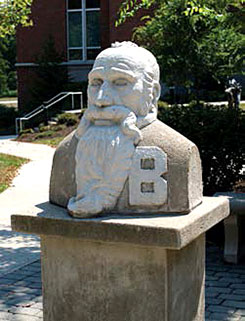
Originally situated between Centennial Hall and Founders Hall, this concrete bust of Menno Simons by Jack Earl is a “Bluffton-ized” reproduction of John Klassen’s marble bust of Menno Simons that resides in Musselman Library. Here, Menno is lifesized and dressed in a Bluffton varsity jacket. This sculpture was moved to the Marbeck Center Gallery Lounge.

John Klassen’s sculptural take on the story of the Good Samaritan, found in the Gospel of Luke 10:25-37, was created ca. 1969 and rests on the third
floor of Centennial
Hall. Klassen was well into his 80s when he produced this
limestone piece, perhaps one of his finest.

Situated outside the north entrance of Centennial Hall, the bronze sculpture Running Dog with Monkey by Jaye Bumbaugh shows a wiry dog in full sprint with a monkey, facing backwards, perched on his back. As anatomically incorrect as representations of two animals can be, the dog creates a willing vehicle for the monkey. Beyond the fluidity of its design, Bumbaugh hopes the viewer perceives the interdependency, harmony and contradictions, such as the pleasure and dependency of the monkey and the willingness of the dog to accommodate another while taking joy from the power and movement of its own body. The piece was installed in 2001 and is part of the Centennial Sculpture Garden that surrounds Centennial Hall. It was created in celebration of Bluffton’s 100th year.

Drawing inspiration from a mountaineering course she took at Bluffton, Mary Kline Roynesdal created the bronze sculpture, Reaching Their Goal, One Step at a Time, which stands outdoors at the northeast corner of Centennial Hall. The sculpture depicts two figures, a man and a horse, physically struggling to reach the top of a mountain. Both of the subjects’ heads are down as they concentrate their energy on reaching the top, and one can perceive the figures’ toned musculature in the shiny bronze as they struggle in their ascent. The piece was installed in 2001 and is part of the Centennial Sculpture Garden.

A two-sided, tattered-edged, rectangular piece of bronze that bears both identifiable and nondescript markings, The Last First Draft by Gregg Luginbuhl visually illustrates the process of creating a first draft. The sculpture displays the graphic quality of a first manuscript. It reveals Luginbuhl’s process of writing the poem “In the ruins,” which he first began composing during a walk through the ancient Greco-Roman ruins in Rome, Italy. “I have always loved the visual energy of a handwritten first draft of a manuscript,” says Luginbuhl. “The graphic quality of direct and sometimes frenetic markings — with alterations, doodles and illustrations in the margins, between the lines and layered over text—mark the trail of a journey.” The piece was installed in 2001 and is part of the Centennial Sculpture Garden.

Consisting of two structures standing at 5’ and 13’, Centennial Gate is a welded-steel sculpture that welcomes visitors on their path through the Centennial Sculpture Garden and reflects many of the natural shapes and formations found on campus. Painted white, the pieces stand across the sidewalk from one another on the east side Centennial Hall and serve as a gate of sorts. Together, the two pieces prompt viewers to think about natural formations, and especially Bluffton’s landscape and the Little Riley Creek. “This piece, an architectural structure in the midst of natural shapes, is like the Bluffton campus, which has always reflected these—the woods, Riley Creek, hills,” says Steve Smith. The piece was installed in 2001 and is part of the Centennial Sculpture Garden.

The untitled bronze work by internationally known ceramist and sculptor Paul Soldner greets those approaching Centennial Hall from the College Avenue entrance. The sculpture is comprised of various pieces of bronze attached to one another and is representative of Soldner’s work in clay and bronze since the early 1980s. The tensile strength of bronze gives the artist freedom to project the object out dramatically over its narrow base, creating the sense that the piece might leave its pedestal and take flight. Soldner, who was instrumental in pioneering American raku, a kiln technique, has conducted more that 400 workshops and 300 solo exhibits. His sculpture was installed in 2001 and is part of the Centennial Sculpture Garden.

Unveiled in 1996, Paul Granlund’s Constellation Earth is a bronze sculpture that illustrates the unity of all human races and people. It is a replica of a Granlund’s original sculpture that was installed in Peace Park in Nagasaki, Japan. Situated in Snyder Circle, in front of Centennial Hall, this work of art welcomes those who approach campus via College Avenue. The sculpture displays seven human figures held together by an intangible force. For Granlund, the sculpture is a microcosm of the universe. Each figure represents a different continent, each continent represents a planet, and each planet is a star that, with the rest, forms the Constellation Earth. The bronze medium suggests strength and timelessness. The nude figures are all the same color and are bound by the same substance crucial for human existence. In depicting the figures like this, Granlund hopes to break through the superficial constructions of humans.

Just inside the doors of Musselman Library are marble busts of Menno Simons and Noah C. Hirschy. They are two of the first major pieces created by John Klassen after he settled in Bluffton with his family in 1924. “These beautiful sculptures immediately gave witness to his exquisite skill as a sculptor,” writes Klassen’s son Paul in “John P. Klassen and the Beginnings of the Art Legacy at Bluffton University” which appeared in the spring 2008 issue of Mennonite Life. “It seems very fitting that his subjects were the first president of the college and the founder of the Mennonite church, and both also filling a huge space in his own life.”

Also housed in Musselman Library is the bronze sculpture Horse and Fallen Rider by Dietrich Rempel, one of John Klassen’s early students. “Rempel, like his teacher, was a Mennonite refugee from Russia,” writes Paul Klassen in his 2008 Mennonite Life article. “He had managed to escape, but his brother was killed in his attempt. This casting is a beautiful tribute to his brother and shows an amazing skill in sculpture for a young student.”

A series of eight raku-fired ceramic plates, The Creation Series documents the story of Creation found in the first chapter of Genesis. While the biblical text provides a written description of the beginning of the universe, faculty-artist Gregg Luginbuhl uses his knowledge of modern science along with his imagination to create a visual representation of a time that no human being can remember. Created in 1991, the plates are displayed in the foyer of Yoder Recital Hall. The first plate, Spirit on the Water, illustrates the formation of the universe. Let There be Light depicts the creation of light, while the separation of sky and water is represented in Separation of the Firmament. Land Amidst the Waters illustrates the creation of land and its separation from the seas. Let Earth Put Forth shows the creation of vegetation, and Two Great Lights illustrates the creation of the sun and the moon and, thus, the division of day and night. The Peaceable Kingdom offers a sample of the many animals that God created. The eighth and final plate, Creation of Human Kind, represents the emergence of human life and was inspired by elements from Michaelangelo’s Sistine Chapel ceiling panel.

Accomplishment Beavers
by Forest Musser '29, outside greenhouse, near Founders Hall

Swords to Plowshares
Illustrated by Amanda Huston '13, written by Lisa Weaver and published by the Lion and Lamb Peace Arts Center.